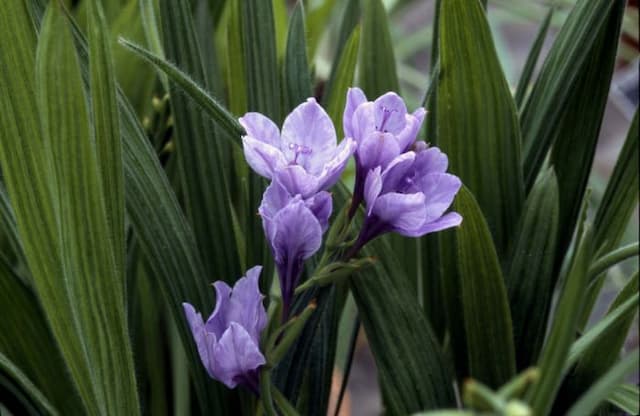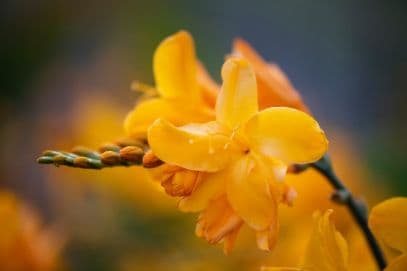Siberian Iris Iris 'Lavendelwein' (Sib)

ABOUT
The Iris 'Lavendelwein', also known as Siberian Iris, is an elegant, clump-forming perennial that boasts a captivating appearance. This plant is characterized by its graceful, slender foliage and stunning flowers. The leaves are long, thin, and grass-like, creating an arching fountain of rich green that provides a lush backdrop for the blooms. The flowers of the Siberian Iris 'Lavendelwein' are particularly striking due to their unique color and form. Each blossom displays a lovely shade of lavender, hinting at a wine-like hue that inspires its name. The petals have a satiny sheen and a smooth, velvety texture, which adds to the plant's overall beauty. The Siberian Iris has a complex floral structure with six petal-like parts: three upright standards and three downward curving falls. The falls often showcase a splash of contrasting color or intricate veining, with a delicate crest emanating from the center, while the standards rise gracefully above. This intricate display is a magnet for garden enthusiasts and pollinators alike. This Iris blooms in late spring to early summer, providing a showy display when many other spring flowers have faded. The Siberian Iris 'Lavendelwein' is not only a feast for the eyes but also hardy and resilient, adding to its popularity among gardeners who seek both beauty and reliability in their plant choices. Its clumping habit and rich, strap-like foliage continue to contribute to the garden's aesthetic even after the blooms have gone, offering structure and contrast to surrounding plantings.
About this plant
 Names
NamesFamily
Iridaceae
Synonyms
Siberian Iris
Common names
Iris 'Lavendelwein' (Sib)
 Toxicity
ToxicityTo humans
Siberian Iris, including the 'Lavendelwein' cultivar, is considered mildly toxic if ingested. The plant contains irisin, iridin, or irisine which can cause gastrointestinal discomfort. Symptoms of poisoning may include nausea, vomiting, abdominal pain, and diarrhea. Ingesting large quantities can lead to more severe health issues.
To pets
Siberian Iris, including the 'Lavendelwein' cultivar, is also mildly toxic to pets such as dogs and cats. Ingesting parts of the plant can cause symptoms similar to those in humans, including vomiting, diarrhea, lethargy, and stomach pain. If a pet consumes a significant amount, it could result in more serious health problems, and thus seeking veterinary attention would be recommended.
 Characteristics
CharacteristicsLife cycle
Perennials
Foliage type
Deciduous
Color of leaves
Green
Flower color
Lavender
Height
3 feet (0.9 meters)
Spread
2 feet (0.6 meters)
Plant type
Bulb
Hardiness zones
4
Native area
Asia
Benefits
 General Benefits
General Benefits- Ornamental Appeal: Iris 'Lavendelwein' adds aesthetic value to gardens with its attractive lavender colored blooms.
- Drought Tolerance: Once established, it is fairly tolerant of drought conditions, making it suitable for water-conservative gardens.
- Low Maintenance: It generally requires minimal care beyond basic watering and occasional fertilization, making it ideal for gardeners of all levels.
- Cold Hardy: This Iris variety is capable of withstanding cold temperatures, making it a robust addition to many climate zones.
- Attracts Pollinators: Its flowers can attract bees and other pollinators, which are beneficial for the health of the garden ecosystem.
- Deer Resistant: The plant is not typically a preferred food source for deer, reducing the risk of damage in areas with deer populations.
- Multiplication: It can readily multiply each year, providing more plants over time that can be divided and transplanted.
 Medical Properties
Medical Properties- This plant is not used for medical purposes.
 Air-purifying Qualities
Air-purifying QualitiesThis plant is not specifically known for air purifying qualities.
 Other Uses
Other Uses- Artistic inspiration: The striking lavender hues and elegant form of the Siberian iris can serve as a muse for painters and photographers seeking to capture the essence of spring in their art.
- Floral Arrangements: Both fresh and dried, the blossoms of the Siberian iris add a sophisticated touch to bouquets and indoor floral displays with their unique texture and color.
- Garden Design: Utilized as a 'thriller' plant in container gardening, the Siberian iris provides an impressive vertical contrast to rounded plants in mixed plantings.
- Natural Dyes: The petals of the Siberian iris plant can be boiled to create natural dyes for fabrics, offering hues ranging from soft purples to rich blues.
- Culinary Garnish: Although not widely recognized for culinary uses, Siberian iris flowers can be used as a decorative garnish for salads and desserts that require an elegant touch.
- Insect Habitat: The foliage and flowers can offer shelter and breeding grounds for beneficial garden insects, such as certain bees and butterflies.
- Feng Shui: Some practitioners may use Siberian iris in the garden to balance the flow of energy and to symbolize purity and wisdom in Feng Shui practices.
- Photography Prop: With their picturesque blooms, Siberian irises are often used by photographers as a natural prop in portraits and scenery photography.
- Educational Tool: Botany teachers and horticultural instructors can use Siberian iris as a living example to teach plant morphology and hybridization methods.
- Pond Borders: Planting Siberian iris around garden ponds can create natural-looking borders that blend well with the aquatic environment and attract wildlife.
Interesting Facts
 Feng Shui
Feng ShuiThe Siberian iris is not used in Feng Shui practice.
 Zodiac Sign Compitability
Zodiac Sign CompitabilityThe Siberian iris is not used in astrology practice.
 Plant Symbolism
Plant Symbolism- Royalty: Derived from the Greek word for rainbow, Iris often symbolizes royalty due to its regal colors and stately appearance.
- Wisdom: The Iris is linked to wisdom, valued for its ability to convey messages through its vast range of colors and shape.
- Hope: The Iris is a harbinger of hope, its resilience and the way it rises on slender stems inspire optimism.
- Trust: Giving someone an Iris can be a symbol of trust, reinforcing belief in the relationship.
- Purity: White varieties of Iris, in particular, are often associated with purity and innocence.
- Courage: In some contexts, the Iris represents courage, perhaps because of its bold colors and ability to thrive in a variety of environments.
- Admiration: This flower can also signify admiration and compliments towards someone's qualities and accomplishments.
 Water
WaterSiberian iris, including the Iris 'Lavendelwein', prefer consistently moist soil, especially during the growing season. Water them deeply once a week, supplying about one to two inches of water. This equates to approximately 0.5 to 1.5 gallons for an average-sized plant. During particularly hot or dry periods, you may need to water them twice a week. Always check the soil moisture beforehand; it should be moist but not waterlogged. Adjust your watering schedule according to rainfall and temperature changes, reducing water in the cool dormant season.
 Light
LightThe Siberian iris thrives best in full sun to partial shade. A location that receives at least six hours of direct sunlight per day is ideal. However, in very hot climates, they can benefit from some afternoon shade to protect them from the intense heat. Ensure that your Iris 'Lavendelwein' isn't in a spot where buildings or trees cast too much shadow throughout the day.
 Temperature
TemperatureThe ideal temperature range for a Siberian iris like Iris 'Lavendelwein' is between 60 to 75 degrees Fahrenheit. They can tolerate a minimum temperature of around -30 degrees Fahrenheit and a maximum temperature of about 90 degrees Fahrenheit. These irises are hardy and can withstand seasonal temperature fluctuations, making them suitable for a range of climates.
 Pruning
PruningPruning Siberian irises like Iris 'Lavendelwein' involves removing dead foliage and spent flower stems to encourage new growth and maintain a tidy appearance. Prune after blooming by cutting flower stems close to the base. In late fall or early spring, remove any dead leaves or damaged foliage. Pruning is typically done once a year, but deadheading spent flowers can be done as needed during the blooming season.
 Cleaning
CleaningAs needed
 Soil
SoilSiberian Iris 'Lavendelwein' prefers a well-draining loamy soil with a pH of slightly acidic to neutral, around 6.5 to 7. Amend the soil with organic material for optimal growth.
 Repotting
RepottingSiberian Iris 'Lavendelwein' typically does not need to be repotted often as it is usually grown outdoors; divide every 3-5 years to maintain vigor.
 Humidity & Misting
Humidity & MistingSiberian Iris 'Lavendelwein' is tolerant of a wide range of humidity levels and does not have specific humidity requirements, thriving in outdoor conditions.
 Suitable locations
Suitable locationsIndoor
Place in bright, indirect light, keep cool in winter.
Outdoor
Full sun to part shade, moist fertile soil, divide every few years.
Hardiness zone
3-9 USDA
 Life cycle
Life cycleThe Siberian Iris 'Lavendelwein' begins its life cycle when the seeds germinate in late spring or early summer under appropriate moisture and temperature conditions. It then develops a rhizomatous root system and foliage, with narrow, grass-like leaves emerging and forming clumps. Throughout the growing season, the plant continues to develop and strengthen its root system and foliage. In late spring to early summer of the following year, it produces tall, sturdy stems that bear the characteristic lavender-violet flowers with distinctive markings. After blooming, the plant sets seed, which can be dispersed to produce new plants, while the foliage continues to gather energy through photosynthesis before dying back in the fall. The plant then overwinters as a rhizome, conserving energy to restart the cycle the next growing season.
 Propogation
PropogationPropogation time
Late Summer-Early Fall
The Siberian Iris 'Lavendelwein' is commonly propagated by division, a method best performed in late summer after flowering has ceased or in early fall. Division involves gently digging up the clump of iris rhizomes and carefully separating them, ensuring each division has at least one fan of leaves and a section of healthy roots. These divisions can then be replanted in well-prepared soil, spaced around 18 to 24 inches (approximately 45 to 60 centimeters) apart to allow sufficient room for growth. It's important to plant the rhizomes shallowly, with the top of the rhizome just below the surface of the soil, and water them in well. This method allows gardeners to rejuvenate their iris clumps, encouraging more vigorous growth and better flowering in the following season.









